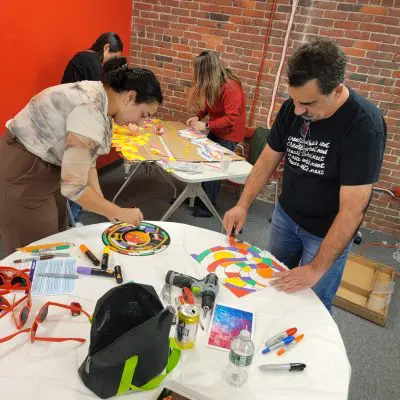Businesses always look for ways to improve, grow, and prepare for challenges. Organizational development allows companies to identify possible issues and implement changes to keep operations running smoothly.
On our latest podcast episode, Scenario Planning: From “What If” to “What’s Next,” we talked with Jeremy Nulik of Bigwidesky about how leaders can craft the future of their organization, including the role of organizational development in business growth.
What is Organizational Development?
Let’s start at square one—what is organizational development (OD)? OD is an ongoing and systematic process used to improve a company’s long-term growth by aligning people and processes.
OD strategy can vary from business to business, but the basic idea is the same. Our guest, Nulik, explained the importance of OD well, saying:
People don’t typically follow a plan, you know. There’s so many great plans that sit and gather dust. But why might that be? Well, because there isn’t a vision that’s actually animating what that plan means.
OD is all about having a plan–a vision–and taking action to make that a reality through the methods laid out in OD.
HR and OD
So, what is organizational development in HR and why does it matter? HR and OD are closely connected: OD can be utilized by HR leaders to help the organization actualize its mission statement and goals.
For example, OD initiatives often focus on increasing leadership capabilities, culture, and employee engagement. Those can all create a more motivated and engaged workforce, which benefits HR. OD can also help HR with change management. By providing a good working structure, HR can more effectively deal with change in management, mergers, acquisitions, and more.
And those are just a few of the benefits. Many other benefits include improved retention, talent management, collaboration, and teamwork.
Organizational Development Goals
Before moving on, let’s talk a bit more about the benefits of OD. The whole point of OD is to improve your organization, so knowing what your goals are is key. Here are some benefits:
- Higher adaptability to change
- Improved communication
- Increased performance and efficiency
- More effective talent management
- Improved conflict resolution
- Healthier company culture
- Stronger leadership
- More sustainable growth
5 Stages of Organizational Development
There are five stages of organizational development. Understanding these stages is key to knowing what is organizational development and being able to implement it. So, let’s go through each of those stages:
Entry: This stage involves learning about the current organization, its strengths, weaknesses, opportunities, and threats.
Diagnosis: Next up is diagnosing the issues identified in step one, setting goals, and making a plan/picking interventions to achieve those goals.
Feedback: After that comes the implementation of interventions, as well as providing/receiving feedback so you can make any necessary changes.
Solution: This is essentially the improvement phase; make changes identified in the feedback stage, measure the impact, and evaluate the effectiveness.
Evaluation: The last phase is to make these changes permanent. Work them into the culture and methods of the organization, and continue evaluating and improving.
Organizational Development Interventions
There are many different organizational development interventions you can utilize, and intervention strategies can change depending on the specific organization. The focus though is bringing about the change you want to see. Nulik highlighted this when he said:
What’s the future of business? Well, it’s what you make it. You have agency in shaping the kinds of things you want. So if you don’t like it, look for your leverage points; look for the places where you can have influence; look for the places where you can tell stories about the kinds of futures you want to see; find the people who care about them the way that you do; and do the work.
So, let’s go through five interventions you can use for organizational development.
Diagnostic Interventions
Diagnostic interventions are focused on identifying issues with an emphasis on data. They assess current functioning, identify strengths and weaknesses, and provide insights with data that can be used to improve functions.
Human Process Interventions
As you can probably guess, human process interventions focus on the human element. These interventions are related to personal, interpersonal, and group dynamics.
The typical goal of human process interventions is to improve communication in the workplace, which can resolve many other issues such as conflict management and change internal transitions. These were also the earliest forms of interventions identified.
Techno-structural Interventions
Again, the name is fairly on the nose; techno-structural interventions are focused on technological and structural issues within an organization. These issues include organizational design, structure, work redesign, employee engagement, and more.
Human Resource Management Interventions
Human resource management interventions put an emphasis on issues generally relating to HR, including things like employee wellbeing, DEI&B, and organizational design.
This form of intervention is often overlooked in favor of more data and profit-focused initiatives, but HR and employees are a big focus of what is organizational development. It’s important not to overlook these aspects of OD.
Strategic Change Interventions
Lastly are strategic change interventions. These interventions are typically used around big organizational change and development, including mergers, acquisitions, restructuring, transformational change, and more.
Team Building as an Intervention Strategy
Before wrapping things up, let’s talk a little bit more about intervention strategies and the impact they can have. One common and popular choice for human process interventions is team building. Team building is considered a human process intervention since it focuses mostly on employees and their situation(s). They also have similar goals such as improving wellbeing, DEI, communication, and group dynamics.
The best way to understand what is organizational development is by looking at examples of interventions and how they actually work. So, let’s go through a few examples of team building as an intervention strategy to help you understand how team building can help your company anticipate change and make positive strides toward success.
Charitable Events
Charitable events are a great option for an intervention strategy. Charity can serve as an opportunity to give back while employees get to bond, deepen relationships, and improve their communication/teamwork skills.
The Donation Station for example is an event that’s perfect or organizational development. Your teams will come together to create donation kits that are sent to charities, directly helping those in need.
This event not only helps you make a difference in the world, but it can help your team get closer than ever before, improve their skills, and have a shared experience that has lasting impacts.
Scavenger Hunts
Scavenger hunts are another option for organizational development. Though a scavenger hunt might seem like a fun and frivolous activity with few benefits, they do a great job of bringing your team together to solve problems and learn communication techniques.
Our Go Team event is a modern-day scavenger hunt that utilizes GPS to send your team on a fun and exciting scavenger hunt to find photos, videos, and other comical target items. This event can also be fully customized to your team’s needs and preferences.
Creative Activities
Creative activities, such as painting or drawing together, are great opportunities for your team to use their imagination and grow comfortable sharing new ideas with each other.
An example of this is The Big Picture. This event involves small teams creating a small piece of a mural together. These smaller pieces are then stitched together to create one big mural that symbolizes their unified efforts.
This event emphasizes collaboration, teamwork, and creativity, which can be valuable tools when it comes to organizational development and OD strategy.
Spark Change at Your Company with TeamBonding
What is organizational development? It is an essential tool for leaders and HR professionals that can be used to guide change and push a company to great heights. Team building events are one of the most effective intervention strategies for organizational development, and they can help you improve upon key areas while bringing teams together and uniting them around a common goal.
If you’re ready to spark change at your company, try working with TeamBonding. We have a wide range of events that are suited to a variety of needs, including organizational development, so get in touch with us today.

















